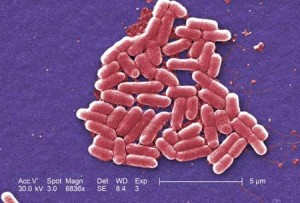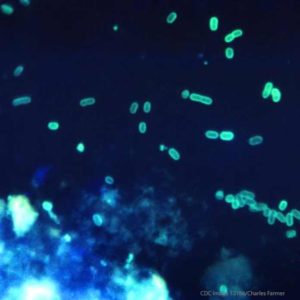The damage to the body caused by E. coli (usually E. coli O157:H7) comes from the production of compounds called Shiga toxins, which are produced by the E. coli bacterium in the colon of the person with E. coli food poisoning. These bacteria are referred to as STEC.

There are two types of Shiga toxin: Shiga toxins I and II (Stx1 and Stx2). Each toxin has 6 subunits; one that causes the toxic effect of the protein, and 5 that bind to receptors on target cells in the colon.
Shiga toxin-producing E. coli (STEC) causes a condition known as hemorrhagic colitis, which causes the bloody diarrhea associated with E. coli O157:H7 infections. In severe cases of E. coli colitis, a colectomy (surgery to remove part or all of the colon) may be required. Read about E. coli colectomy information.
When Shiga toxin is released from an E. coli O157:H7 bacterium, it can translocate to organs other than the digestive tract, such as the kidneys and central nervous system (brain and spinal cord). This can cause hemolytic uremic syndrome (HUS) and/or thrombotic thrombocytopenic purpura (TTP).
The ability of the toxins to pass through cell barriers is possibly due to the increased permeability of the intestinal epithelial cells resulting from effects of the body’s own immune system. The body increases permeability of cell barriers so that important cells of the immune system (neutrophils/PMN’s) can reach the E. coli infection. Shiga toxin may use this opportunity to break through the walls of the digestive tract,1 enter the blood stream, and bind white blood cells for transport to locations such as the kidney or brain.

Once Shiga toxin reaches a target organ such as the kidney, it binds to receptors on cell membranes known as globotriaosylceramide or GB3. The toxin is then brought inside the cell and transported to the Golgi apparatus, endoplasmic reticulum, and finally to the nuclear membrane.
When the Shiga toxin enters cells, the toxin, itself a protein, stops the cells from producing proteins it needs to function. Without the ability to sustain its function, the cell dies through either apoptosis (programmed cell death) or necrosis.2 By killing cells crucial for organ function, Shiga toxins have a debilitating effect on the body.
Research has found that even “mild” cases of E. coli poisoning can cause kidney and other organ damage years into the future. This is why an E. coli lawsuit should seek compensation for future medical care.
Our E. coli lawyers have won millions for our clients. They have appeared on CBS News, Fox News, and numerous local stations. Our law firm is listed in U.S. News and World Report’s The Best Law Firms in America.
Sources:
- Cherla RP, Lee SY, Tesh VL. 2003. Shiga toxins and apoptosis. FEMS Microbiol Let. 228: 159-166.
- Hurley BP, Thorpe CM, Acheson DWK. 1998. Shiga toxin translocation across intestinal epithelial cells is enhanced by neutrophil transmigration. Infect Immun. 69:10: 6148-6155.